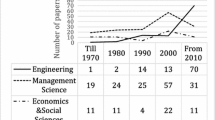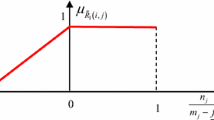Abstract
Preference for a set of alternatives evaluated under multiple criteria is frequently expressed in the form of pairwise comparisons. We propose a linear goal programming model for deriving the partial and overall preference values of the alternatives directly from pairwise comparisons. This model can be a useful alternative to AHP. The partial values represent the contribution of the criteria to the overall preference. Simulation experiments, which are conducted to compare the performance of the model with that of two other existing models, show that the model has good performance.
Similar content being viewed by others
References
T.L. Saaty, Multicriteria decision making: The Analytic Hierarchy Process, RWS Publication, Pittsburgh, PA, 1990.
A. Arbel, Approximate articulation of preference and priority derivation, Euro. J. Oper. Res. 43 (1989)317–326.
N. Bryson, A goal programming method for generating priority vectors, J. Oper. Res. Soc. 46 (1995)641–648.
W.D. Cook and M. Kress, Deriving weights from pairwise comparison ratio matrices: An axiomatic approach, Euro. J. Oper. Res. 37(1988)355–362.
J. Fichtner, On deriving priority vectors from matrices of pairwise comparisons, Socio-Econ. Plann. Sci. 20(1986)341–345.
A. Hashimoto, A note on deriving weights from pairwise comparison ratio matrices, Euro. J. Oper. Res. 73(1994)144–149.
P.E. Green and V. Srinivasan, Conjoint analysis in consumer research: Issues and outlook, J. Consumer Res. 5(1978)103–123.
D. Pekelman and S.K. Sen, Mathematical programming models for the determination of attribute weights, Mgmt. Sci. 23(1974)1217–1229.
V. Srinivasan, Linear programming computational procedures for ordinal regression, J. Assoc. Comp. Mach. 23(1975)475–487.
E.U. Choo and W.C. Wedley, Optimal criterion weights in repetitive multicriteria decision-making, J. Oper. Res. Soc. 36(1985)983–992.
K.F. Lam and E.U. Choo, Goal programming in preference decomposition, J. Oper. Res. Soc. 46(1995)205–213.
J. Johnston, Econometrics Methods, 2nd ed., McGraw-Hill, 1972.
T.J. Stewart, A critical survey on the status of multiple criteria decision making theory and practice, Omega 20(1990)569–586.
A.A. Salo and R.P. Hamalainen, Preference programming through approximate ratio comparisons, Euro. J. Oper. Res. 82(1995)458–475.
P.E. Green and V. Srinivasan, Conjoint analysis in marketing: New developments with implications for research and practice, J. Mktg. 54(1990)3–19.
N. Bryson, A. Mobolurin and O. Ngwenyama, Modelling pairwise comparison on ratio scales, Euro. J. Oper. Res. 83(1995)639–654.
B. Schoner, W.C. Wedley and E.U. Choo, A unified approach to AHP with linking pins, Euro. J. Oper. Res. 64(1993)384–392.
B. Schoner and W.C. Wedley, Ambiguous criteria weights in AHP — consequences and solutions, Decision Sciences 20(1989)462–475.
T.L. Saaty, Eigenvector and logarithmic least squares, Euro. J. Oper. Res. 48(1990)156–160.
D.R. Wittink and P. Cattin, Alternative estimation methods for conjoint analysis: A Monte Carlo study, J. Mktg. Res. 18(1981)101–106.
T.W. Leigh, D.B. Mackay and J.O. Summers, Reliability and validity of conjoint analysis and self-explicated weights: A comparison, J. Mktg. Res. 21(1984)456–462.
P.E. Green and K. Helsen, Cross-validation assessment of alternatives to individual-level conjoint analysis: A case study, J. Mktg. Res. 26(1989)346–350.
R. Mehta, W.L. Moore and T.M. Pavia, An examination of the use of unacceptable levels in conjoint analysis, J. Consumer Res. 19(1992)470–476.
P.E. Green, A.M. Krieger and C.M. Schaffer, An empirical test of optimal respondent weighting in conjoint analysis, Journal of the Academy of Marketing Science 21(1993)345–351.
Conjoint Analyzer, Bretton-Clark, Morristown, NJ, 1989.
Rights and permissions
About this article
Cite this article
Moy, J.W., Fung Lam, K. & Ung Choo, E. Deriving the partial values in MCDM by goal programming. Annals of Operations Research 74, 277–288 (1997). https://doi.org/10.1023/A:1018930723267
Issue Date:
DOI: https://doi.org/10.1023/A:1018930723267




